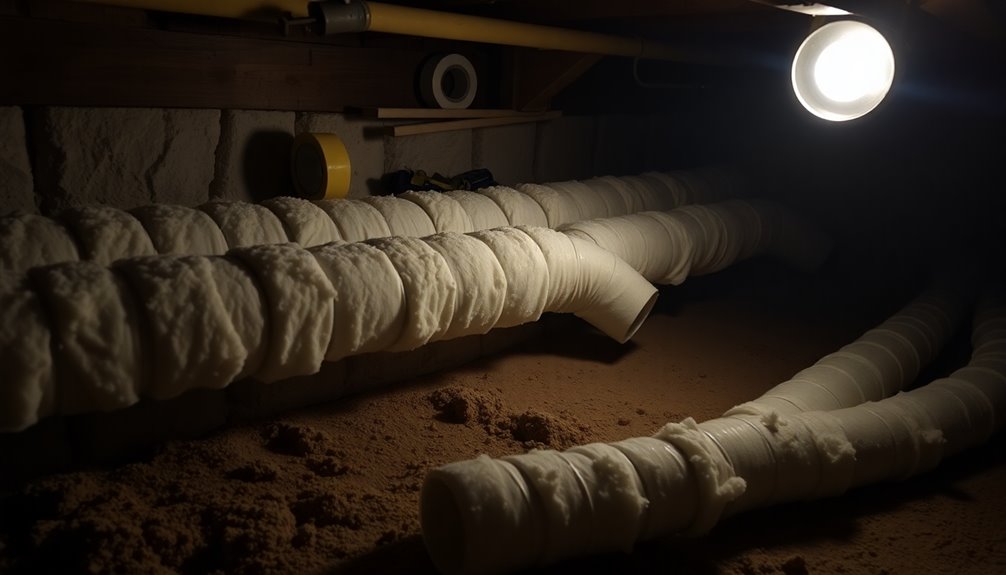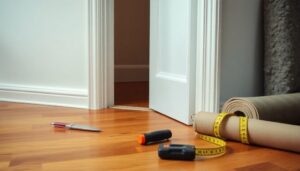To insulate pipes in unheated crawl spaces affordably, start by using foam pipe sleeves. They fit snugly and provide a solid barrier against the cold without needing special tools. Overlap insulation at joints to prevent heat loss. Pay extra attention to areas near vents and exterior walls. You might also consider adding heat cables for extra protection during extreme cold, though they need power. Finally, inspect your insulation regularly to verify it's still effective. With these simple techniques, you can greatly reduce the risk of frozen pipes and save money on repairs. There's plenty more to explore!
The Dangers of Frozen Pipes
Frozen pipes pose a serious threat to your home. When water freezes at 32°F (0°C), it expands, creating pressure that can lead to ruptures, especially at weak points in your plumbing.
A burst pipe can release significant water leaks, resulting in costly damage such as mold growth and extensive structural repairs. You don't want to deal with the aftermath of a pipe bursting, which can escalate repair costs far beyond what you'd spend on preventive measures. Implementing expense tracking tools can help you manage any unexpected costs that arise from plumbing issues, while also ensuring that you can allocate funds toward necessary home improvements.
To avoid these disasters, it's essential to take steps to prevent frozen pipes. One effective way to do this is by implementing insulation methods that protect your pipes from the cold.
Insulating your pipes not only keeps them warm but also minimizes the risk of freezing during those harsh winter months. By investing in these preventive measures, you can save yourself from the high costs associated with repairs and mold remediation. Additionally, these methods can enhance your overall financial management practices by reducing unexpected expenses.
Don't wait until it's too late; guarantee your plumbing system stays intact. Taking action now can help you avoid the inconveniences of a disrupted plumbing system, allowing you to focus on daily activities like cooking and cleaning without worry. Consistent saving habits through budgeting apps can further protect you from the financial strain of unexpected repairs.
Effective Insulation Techniques
When it comes to effective insulation techniques, you've got several material options, like foam pipe sleeves and fibreglass wraps, to choose from. Applying these materials correctly is essential, especially in targeting vulnerable areas around your pipes. Additionally, using sustainable materials for insulation can further enhance energy efficiency and reduce environmental impact. Choosing products with minimal packaging can also help in promoting eco-friendly practices in your home improvement projects. Furthermore, supporting sustainable businesses by choosing eco-friendly insulation products can contribute to a socially responsible economy.
Insulation Material Options
Choosing the right insulation material for pipes in unheated crawl spaces can greatly reduce the risk of freezing and enhance energy efficiency.
One popular option is foam insulation, specifically foam pipe sleeves. They create a thick barrier against cold temperatures and are easy to install over existing pipes, making them ideal for long pipes in cold climates.
Fiberglass pipe insulation is another effective choice due to its high R-value and moisture barrier, which helps prevent mold growth. This material works well for both hot and cold water pipes, although you'll need protective gear during installation.
If you're looking for a lightweight and cost-effective solution, consider reflective or radiant barrier insulation. It reflects heat back into the pipes, but its effectiveness might be limited in extremely cold conditions.
For extreme cold, heating cables or tapes can be a good alternative. These require a power source and proper installation to prevent freezing.
Finally, spray foam insulation can seal irregular areas around pipes, providing excellent air sealing and insulating properties, but it typically needs professional installation and curing time.
Each option has its benefits, so choose what best fits your needs.
Application Methods
To effectively insulate pipes in unheated crawl spaces, start by using foam pipe sleeves, which provide a thick barrier against cold temperatures.
These sleeves are easy to install over existing pipes and offer added protection. When wrapping insulation around exposed pipes, guarantee a snug fit. Overlap the insulation at joints to prevent heat loss, and use adhesive or tape to secure it in place.
Don't forget to insulate all exposed pipes in the crawl space, especially those near vents or exterior walls, to minimize exposure to cold air. This step is essential in reducing the risk of freezing.
For areas prone to extreme cold, consider combining insulation with heat tape or cables. This added layer of protection can greatly enhance your pipes' resistance to freezing temperatures.
Regularly inspect your insulation for any wear or damage. Address any issues promptly to maintain effective thermal resistance and prevent future freezing problems.
Targeting Vulnerable Areas
Effective insulation is essential for protecting your plumbing system from freezing temperatures, especially in vulnerable areas. To keep your pipes in crawl spaces safe, focus on these key spots:
- Areas near vents
- Exterior walls
- Poorly insulated foundations
- Elbow joints and pipe connections
Start by using continuous foam insulation or fiberglass batts to cover the entire length of your pipes. This guarantees all vulnerable areas are shielded from the cold.
Pay special attention to elbow joints and connections; they need extra insulation to effectively retain heat and prevent cold spots.
Don't forget to regularly inspect these vulnerable areas for wear or damage. Even small gaps can compromise your insulation efforts, leading to potential freezing.
In particularly cold sections of your plumbing system, consider combining insulation techniques with heat cables or tape for enhanced protection.
Applying Heat Cables
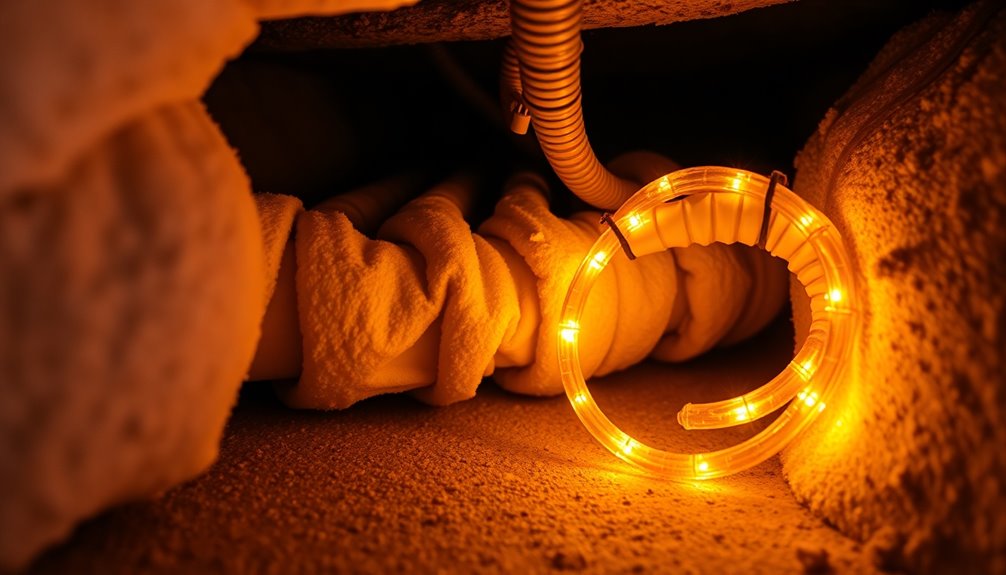
When temperatures drop, applying heat cables can be an essential step in preventing your pipes from freezing. These cables, often referred to as heat tape, provide direct warmth to vulnerable pipes, greatly reducing the risk of frozen pipes. Additionally, using automated notifications can help remind you to check the functionality of your heat cables before the cold sets in. Implementing clear payment terms for the installation service can also enhance transparency and trust with the professionals.
For best results, you should have them installed by professionals, as improper installation can cause malfunctions or even damage your pipes.
Keep in mind that heat cables require an electrical source to operate, which might increase your energy costs, especially in extremely cold climates.
To maximize their effectiveness, it's a good idea to use heat cables alongside other insulation methods, such as foam pipe sleeves. This combination offers enhanced protection against frigid temperatures.
Regular inspections of your heat cables are necessary to verify they're working correctly. This helps avoid potential hazards, like overheating or electrical failures, which can pose risks to your home. Additionally, ensure that you proactively monitor due dates for inspections to maintain optimal performance and safety.
Benefits of Foam Pipe Sleeves
Foam pipe sleeves are a cost-effective way to insulate your plumbing and protect it from freezing in unheated crawl spaces. They can also help you track expenses related to home maintenance by minimizing costly repairs. By ensuring that your pipes are properly insulated, you can contribute to effective financial management through reduced energy costs. They're lightweight and easy to install, allowing you to quickly wrap existing pipes without needing a professional. With a snug fit, these sleeves help maintain consistent temperatures and prevent costly repairs down the line. Additionally, using eco-friendly materials in insulation can further enhance your home's energy efficiency and sustainability.
Cost-Effective Insulation Solution
Insulating your pipes with foam pipe sleeves can save you money while protecting your home from the dangers of freezing temperatures.
These sleeves act as a thick barrier, guaranteeing your pipes remain warm and functional even in unheated crawl spaces. By choosing foam pipe insulation, you're making a smart, cost-effective decision to avoid frozen pipes and the expensive repairs that come with them.
Here are some key benefits of foam pipe sleeves:
- Thick Barrier: Offers robust protection against cold temperatures.
- Lightweight and Flexible: Easy to handle and install on various pipe sizes.
- Snug Fit: Guarantees effective insulation by preventing cold air infiltration.
- Cost-Effective Solution: Minimizes the risk of costly repairs due to frozen pipes.
Regularly inspecting your foam pipe sleeves is essential to maintaining their integrity.
This proactive approach guarantees they continue to provide the protection you need during those frigid months. By investing in foam pipe insulation, you're not just enhancing your home's resilience; you're also safeguarding your wallet from potential disasters.
Easy Installation Process
Installing foam pipe sleeves is a breeze, making it an ideal choice for homeowners looking to protect their plumbing without hassle. These sleeves are designed for easy installation, allowing you to simply slide them over existing pipes. You won't need any specialized tools or professional assistance, which saves you time and money.
Foam pipe sleeves create a thick barrier against cold temperatures, effectively insulating pipes in unheated crawl spaces. They come in various sizes and can be easily cut to fit any length of pipe, ensuring a snug and secure fit for maximum insulation.
This lightweight material is easy to handle, further streamlining the installation process.
Additional Preventive Measures
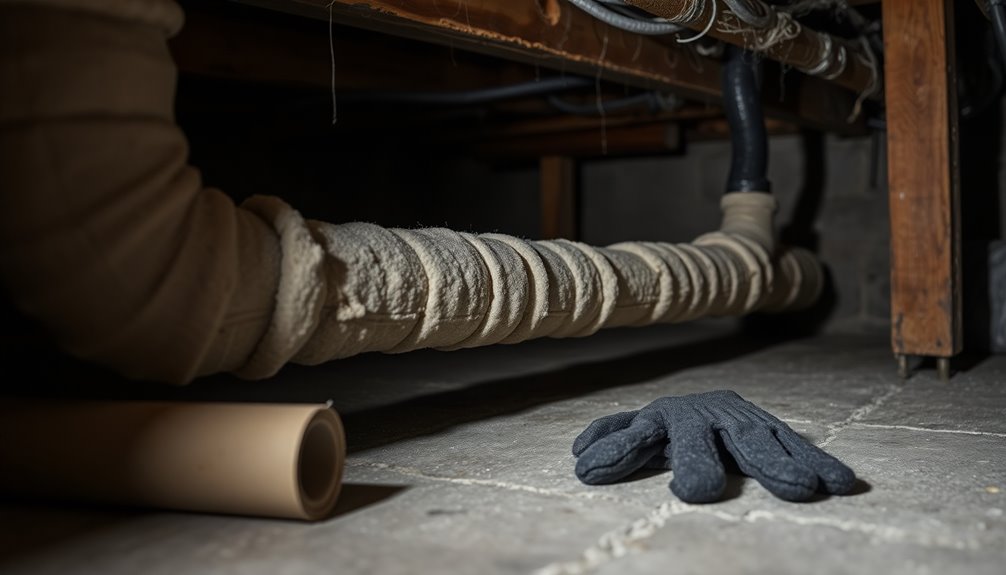
Taking proactive steps can greatly enhance the protection of your pipes in unheated crawl spaces.
By implementing a few additional preventive measures, you can effectively keep pipes from freezing and reduce the risk of costly water damage.
Here are some essential tips to take into account:
- Turn off outdoor taps and drain hoses before winter to prevent water from freezing inside.
- Allow faucets to drip slightly to relieve pressure buildup in pipes, considerably lowering the chances of freezing.
- Maintain a warm indoor temperature—ideally above 65°F—to help keep your crawl space pipes warm. Consider incorporating automated savings tools to save for any potential heating costs that may arise in winter. Additionally, utilizing a budgeting app can help manage your finances during the colder months.
- Seal air leaks around windows, doors, and foundation cracks to maintain a consistent temperature in your crawl space.
In addition, consider using expense tracking apps to ensure that any potential plumbing repairs can be monitored and managed within your budget.
Types of Insulation Materials
When protecting your pipes in unheated crawl spaces, the choice of insulation materials plays a significant role. You'll find several types of insulation that can effectively keep pipes from freezing, each with its own unique benefits.
Polyethylene with a split edge is lightweight and flexible, providing excellent thermal resistance against freezing temperatures.
If you're dealing with both hot and cold water pipes, consider fiberglass wrap. It has a high R-value but requires careful handling to avoid skin and lung irritation during installation.
For areas prone to humidity and condensation, closed-cell foam insulation is a great option. It's moisture-resistant and fits snugly around pipes.
Rigid foam board insulation works well for larger pipes, offering a durable barrier against cold air infiltration.
When choosing insulation materials, think about your local climate conditions. If you live in a colder region, you might need more robust insulation solutions to effectively keep pipes from freezing.
Best Practices for Insulation
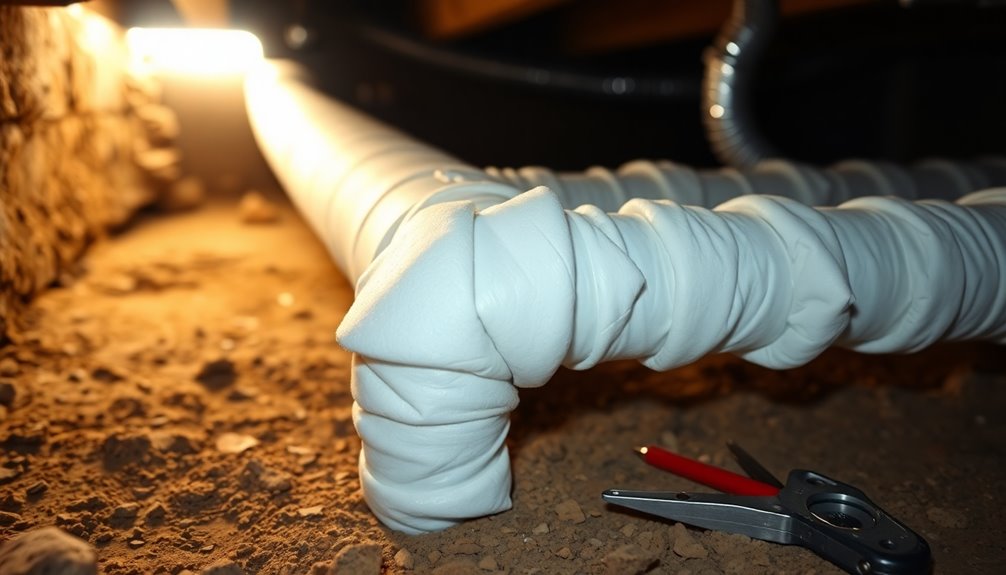
Effective insulation of pipes in unheated crawl spaces requires careful attention to detail. To guarantee your pipes are protected against freezing, follow these best practices:
- Cover the entire length of exposed pipes, especially in vulnerable areas, to prevent cold air infiltration.
- Use a combination of insulation materials, like foam pipe sleeves and fiberglass batts, for a snug fit and improved thermal resistance.
- Pay special attention to joints and elbows, as these areas are more prone to heat loss. Seal them properly with additional tape or insulation.
- Regularly inspect your insulation for wear or damage, and address any issues promptly.
Regional Climate Considerations
Climate plays an essential role in determining how you should insulate pipes in unheated crawl spaces. In colder regions, like Arlington, VA, it's imperative to protect your pipes from freezing. Here, winter temperatures often plummet below freezing, making proper insulation fundamental to prevent damage. High humidity can worsen the situation, leading to condensation and an increased risk of freezing in uninsulated areas.
You also need to take into account seasonal temperature fluctuations when choosing insulation methods. Your approach should effectively address both extreme cold and the occasional warmer days throughout winter.
Be sure to familiarize yourself with local building codes and regulations regarding insulation. This knowledge will guide you in selecting the right materials and techniques suitable for your regional climate.
Regular maintenance and inspections are critical, too. In varying climates, checking your insulation guarantees it remains effective and that any vulnerabilities are promptly addressed before freezing conditions set in.
Conclusion
In summary, insulating pipes in unheated crawl spaces is essential to prevent freezing and costly repairs. For instance, imagine a homeowner in Minnesota who ignored this advice, only to face burst pipes after a harsh winter. By following the tips outlined—like using foam pipe sleeves and heat cables—your pipes can stay safe and sound, saving you from headaches down the road. Don't wait for disaster to strike; take action now to protect your home!

